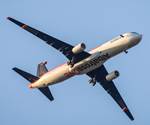DLR tests flexible and actively-controlled wing designs
Carbon and glass fiber aeroelastic and flutter wing concepts tested as part of multi-partner FLEXOP project.
The German Aerospace Center (Deutsches Zentrum für Luft-und Raumfahrt; DLR; Göttingen) has tested two flexible, actively-controlled fiber-reinforced wing designs as part of the EU FLEXOP project.
Involving a collaboration of research institutions from six nations, the FLEXOP project’s aim is to develop new, lightweight wing designs for next-generation aircraft. According to DLR, alongside more fuel-efficient engines and higher-aspect-ratio wings, weight reduction is regarded as the most important way to reduce fuel consumption in the air transport sector. So far, the FLEXOP researchers have designed two wing variants and have been testing the wings in ground vibration tests at the DLR Institute of Aeroelasticity in Göttingen. The testing is being done in comparison with a “standard” carbon fiber-reinforced wing model based on a current commercial wing design.
The first of the new wing designs is called the “flutter wing,” designed by the Technical University of Munich. This wing is made of glass fiber-reinforced composites and is designed for aerodynamic flutter, a behavior in which the oscillations caused by the airflow over the wing become stronger and stronger until a mechanical failure occurs. The DLR Institute of System Dynamics and Control in Oberpfaffenhofen is developing and designing a flight control system to prevent mechanical failures.
The outermost flaps on the trailing edge of the wing are controlled in such a way that they act as dampers. This allows the wing to be much lighter and to have a higher aspect ratio. "Active control significantly increases the possibilities for a much lighter design," says Gertjan Looye, coordinator of DLR's involvement in the project. A second flight control system is being developed by the Hungarian Academy of Sciences Institute of Computer Science and Control (MTA SZTAKI). Project Manager Bálint Vanek of MTA SZTAKI adds: “Such a wing could make it possible to transport 20 percent more freight or use seven percent less fuel.”
The second wing design, called the “aeroelastic wing,” has been developed by the DLR Institute of Aeroelasticity with the University of Delft. Constructed using carbon fiber-reinforced composites, the wing is said to twist under load more extensively than is possible with conventional wing designs, while also maintaining the same stability as standard wings. DLR says the wing is also 20% lighter than the standard carbon fiber-reinforced wing used for comparison in the tests, owing to a specially optimized and unconventional layer structure in the materials.
Later this year, the wing models will be flight tested in Oberpfaffenhofen.
The partners in the EU FLEXOP project include: the Hungarian Academy of Sciences Institute of Computer Science and Control (Magyar Tudományos Akadémia Számítástechnikai és Automatizálási Kutatóintézet; SZTAKI); Airbus Defence and Space GmbH, Airbus Group Innovations; Airbus Group Ltd.; FACC Operations GmbH; Integrated Aerospace Sciences Corp. (INASCO); Technische Universiteit Delft (Delft University of Technology); Technische Universität München (Technical University of Munich); University of Bristol and the Rheinisch-Westfälische Technische Hochschule Aachen (RWTH Aachen University).
Related Content
-
A new era for ceramic matrix composites
CMC is expanding, with new fiber production in Europe, faster processes and higher temperature materials enabling applications for industry, hypersonics and New Space.
-
Plant tour: Middle River Aerostructure Systems, Baltimore, Md., U.S.
The historic Martin Aircraft factory is advancing digitized automation for more sustainable production of composite aerostructures.
-
Welding is not bonding
Discussion of the issues in our understanding of thermoplastic composite welded structures and certification of the latest materials and welding technologies for future airframes.

.jpg;width=70;height=70;mode=crop)














